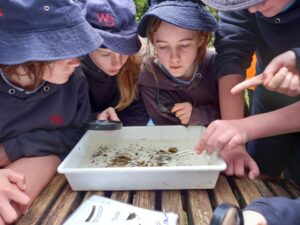The Ōtari Wilton’s Bush student event has been a significant one on the Te Whanganui a Tara Enviroschools calendar since 2017. While the format of the event has evolved over the years, connecting tamariki to taiao and forming deep connections with this special place has remained at the centre.
The September 2024 event was co-ordinated by new Enviroschools facilitator, Chandra, and there were some big shoes to fill! However, by collaborating with Wellington City Council and Zealandia, with support from Porirua City Council, and being hosted in a well-known, significant forest ecosystem and with existing connections to local schools and communities, the event forged its own path.

Identifying macro-invertebrates from the stream.
‘Kia Mouriora te Kaiwharawhara’ restoring the mouri of the Kaiwharawhara whaitua (catchment) is a local project and was the inspiration behind 2 days of nature connection and exploration at Ōtarikākā – Ōtari Wilton’s Bush, which sits within the Kaiwharawhara whaitua.
“My feet are so wet, but I don’t care,” – remarked one participant
Kia Mouriora te Kaiwharawhara Sanctuary to Sea is a collaborative whole-of-catchment restoration initiative working in partnership with mana whenua, Zealandia, organisations and communities throughout the whaitua.
“We wanted our Ōtarikākā student event to support this kaupapa through engaging kaiako in the aspirations prior to the event and which tamariki connected with throughout the day with different activities.” – Facilitation team

Scarifying kōwhai seeds before sowing.
What a privilege to have tauira from Te Kura o Ōtari lead the mihi whakatau, welcoming tamariki, kaiako and whānau to this magical place and for them to reconnect with taiao through this experience! They are now looking into how they can support stream health as well as creating a māra kai back at their kura.
“Before I came into the bush it was wild and chaotic but here it is calm, peaceful and relaxing” – participant
Seven schools and more than 150 tauira participated over the 2 days. They experienced activities that explored tuna migration from awa to moana, with all the obstacles and barriers these magical creatures overcome. Kōwhai seeds were scarified, sowed, and taken back to school or home for planting. Tamariki also wandered through te ngahere, identifying native rākau and the tohu of kōanga.
Nature connection took place through exploration just a few steps from the awa – Te Māhanga, amongst a hidden wonder of rākau and manu, distractions of the day left behind as kākā greeted us boldly and pīwakawaka flitted alongside us.
“It makes me feel calm,” and “We just like to play,” expressed the mood of the experience.

Building an understanding of catchment dynamics.
Experiencing the catchment model, tauira engaged in the connections between wetlands, land stability and water quality, all while being able to think about local context and impacts on local spaces.
“This is the best day ever.” – positive feedback
Insect life is an indicator of another world, often hidden from the naked eye. There were squeals of both delight and wonder as tamariki searched through leaf litter with magnifying glasses and microscopes as well as water samples from the awa.
“This is a reminder of how good it is to get kids here and how much they get out of it” said one kaiako.
One rōpū from a smaller, inner-city school were so inspired by their nature connection they plan to return with their whole school. They really wanted to spend more time ki te ngahere and when their kaiako asked if their Envirogroup could revisit, the Principal suggested the whole school go! This is a powerful commitment to building nature connection and perhaps one that will now become a regular in their school calendar. Clearly one visit to Ōtarikākā is never enough!
The facilitation team are looking forward to hearing what other actions tamariki and kaiako take on after this event and supporting them in their Enviroschools journey.

Feedback from participants.